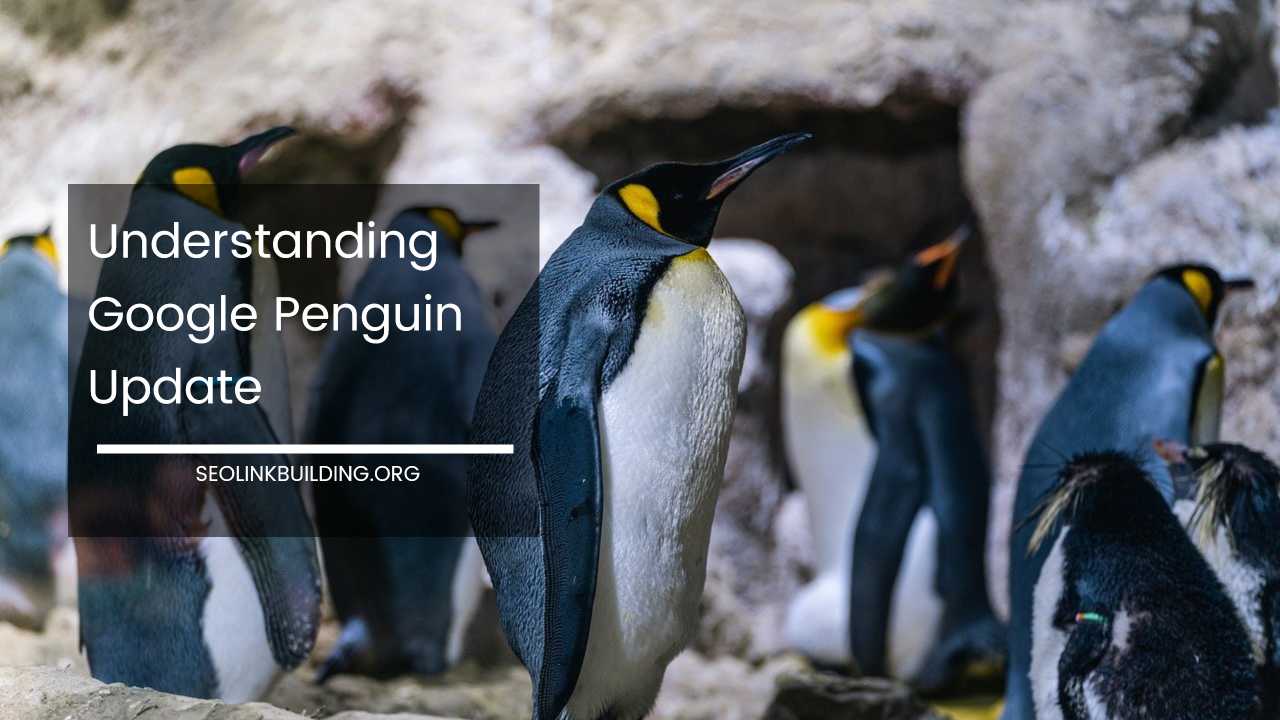Understanding Google Penguin Update

Understanding Google Penguin Update: A Comprehensive Guide to Quality Backlinks and Long-Term SEO Success
In the dynamic landscape of Search Engine Optimization (SEO), keeping pace with Google’s algorithm updates is paramount for websites seeking to maintain a prominent online presence.
One of the most impactful updates in SEO history was the Google Penguin Update, a game-changer that targeted websites employing manipulative link-building tactics to gain an unfair advantage in search rankings.
This comprehensive guide delves into the intricacies of the Google Penguin Update, explaining its purpose, its intricate workings, and its lasting impact on SEO strategies.
We’ll explore not only how to recover from a potential Penguin penalty but also how to cultivate a sustainable, white-hat SEO approach focused on earning high-quality backlinks that deliver long-term value.
The Genesis of Penguin: Combating Webspam and Prioritizing User Experience
Launched in April 2012, the Google Penguin Update emerged as a response to a growing concern – the proliferation of webspam in search results.
Websites were resorting to unethical practices like buying links, participating in link schemes, and keyword stuffing to manipulate their rank in Search Engine Result Pages (SERPs).
These tactics not only delivered a subpar user experience but also devalued the legitimacy of genuine, high-quality content.
The Penguin Update introduced a sophisticated filter within Google’s core algorithm, specifically targeting websites with unnatural backlink profiles.
Backlinks, also known as inbound links, are essentially hyperlinks from other websites that point back to your site.
They act as a vote of confidence from a credible source and play a crucial role in determining a website’s authority and relevance in search results.
Prior to Penguin, webmasters could artificially inflate their backlink profiles with low-quality links, tricking the algorithm into perceiving their website as having greater authority than it truly deserved. Penguin effectively put an end to this manipulation by analyzing the quality and origin of backlinks.
Unveiling the Penguin Algorithm: A Deep Dive into Link Evaluation
While the specifics of the Penguin algorithm remain a closely guarded secret by Google, SEO experts have identified several key factors it considers when evaluating backlinks:
- Link Source Quality: The websites linking to your site are critically important. Are they relevant to your niche and industry? Do they have a good reputation and established domain authority? Links from low-quality, irrelevant websites can negatively impact your ranking.
- Link Anchor Text Analysis: The text used to create the hyperlink is another crucial factor. Penguin penalizes websites with an unnatural concentration of exact-match keywords in their anchor text.
- Link Velocity Monitoring: The speed at which you acquire backlinks is also monitored. A sudden surge of backlinks, especially from questionable sources, can raise red flags for the algorithm.
The current iteration of Penguin operates in real-time, meaning that changes to your backlink profile are continuously monitored and assessed.
This is a significant improvement from the initial version, which required periodic refreshes. If your website exhibits a backlink profile indicative of manipulative practices, you might experience a decline in search rankings, signifying a potential Penguin penalty.
The Ripple Effect: How Penguin Reshaped SEO Strategies
The introduction of Penguin forced SEOs to re-evaluate their entire link-building strategy. Black-hat tactics like buying links and participating in link schemes became obsolete overnight.
The focus shifted towards acquiring high-quality backlinks organically through white-hat SEO strategies, such as:
- Content is King: Crafting High-Quality, Informative Content: Content that is valuable, engaging, and share-worthy naturally attracts backlinks from other websites. When you create content that establishes you as a thought leader in your niche, other websites are more likely to cite you as a credible source.
- Guest Blogging for Strategic Backlink Acquisition: Contributing valuable guest posts to relevant websites in your niche is an excellent way to generate high-quality backlinks. By providing insightful guest content, you not only establish yourself as an expert but also gain valuable exposure to a new audience.
- Building Relationships with Industry Influencers: By fostering connections with influencers in your industry, you increase the chances of them linking to your content. This can be achieved through various means, such as collaborating on content projects, engaging in social media interactions, or participating in industry events.
- Broken Link Building: A Win-Win Strategy: Identifying and reaching out to website owners with broken links on their site, suggesting your relevant content as a replacement, is a win-win strategy. You help them improve their website while potentially earning a valuable backlink.
These white-hat SEO practices not only comply with Google’s guidelines but also build a foundation for long-term SEO success. They cultivate trust and credibility, ultimately leading to organic link acquisition and sustainable website growth.
The Path to Redemption: Recovering from a Penguin Penalty
If you suspect your website has been hit by a Penguin penalty, don’t panic. Here’s a comprehensive roadmap to navigate a potential Penguin penalty and restore your website’s ranking:
-
Conduct a Backlink Audit: The first step is to perform a thorough backlink audit. There are various backlink analysis tools available that can help you identify the quality and origin of your backlinks. Look for links from irrelevant websites, those with excessive keyword-rich anchor text, or links obtained through link schemes.
-
Disavow Low-Quality Backlinks: Google provides a disavow tool that allows you to submit a list of links you want the algorithm to disregard. This essentially tells Google to ignore these backlinks when evaluating your website’s authority. Use the backlink audit to compile a list of low-quality links for disavowal.
-
Link Removal (if possible): For backlinks you have some control over, such as guest posts you’ve written, reach out to the website owner and request the removal of the link. This approach may not always be successful, but it’s worth attempting for links you deem particularly damaging.
-
Focus on Building High-Quality Backlinks: While disavowing and removing low-quality links are crucial steps, the most significant factor in recovering from a Penguin penalty is building high-quality backlinks. Implement the white-hat SEO strategies mentioned earlier, focusing on creating exceptional content, guest blogging on reputable sites, and building relationships with industry influencers.
-
Monitor Progress and Be Patient: Recovery from a Penguin penalty takes time and consistent effort. Once you’ve implemented the steps above, monitor your website’s traffic and rankings for any positive changes. Since Penguin is now part of the core algorithm, positive adjustments should be reflected relatively quickly, but don’t expect overnight success.
Additional Considerations:
- Quality over Quantity: It’s far better to have a few high-quality backlinks from relevant websites than a large number of low-quality backlinks.
- Natural Link Growth: Focus on acquiring backlinks organically. Links should be earned through the creation of valuable content, not through manipulative tactics.
- Staying Informed: The SEO landscape is constantly evolving. Stay updated on Google’s algorithm changes and best practices to maintain a healthy backlink profile and avoid future penalties.
Beyond Penguin: Building a Sustainable SEO Strategy for the Long Haul
The Google Penguin Update serves as a constant reminder that Google prioritizes user experience and rewards websites that offer genuine value.
By focusing on creating high-quality content, building organic backlinks, and adhering to white-hat SEO practices, you can build a sustainable SEO strategy that stands the test of time and algorithm updates.
Remember, SEO is a marathon, not a sprint. Consistent effort, a focus on quality, and a commitment to user experience are the keys to achieving long-term SEO success.
Advanced Backlink Building Techniques: Expanding Your Link Profile
While the core principles of white-hat SEO remain constant, there are advanced backlink building techniques you can explore to further strengthen your link profile:
- Broken Link Building on a Larger Scale: Utilize advanced tools to identify broken links on a broader scale across relevant websites within your niche. This allows you to target high-authority websites with relevant content suggestions.
- HARO Pitching (Help a Reporter Out): HARO is a platform that connects journalists with sources. By identifying relevant HARO queries and providing expert insights, you can earn backlinks from high-traffic news websites.
- Unlinked Brand Mentions: Utilize tools to identify online mentions of your brand that don’t include a hyperlink. Reach out to the website owners and politely request them to add a backlink to your website.
- Infographics and Visual Content Creation: Creating informative and visually appealing infographics can be a great way to attract backlinks. Share your infographics on social media platforms and relevant websites, encouraging others to embed them with proper attribution.
Remember: These techniques should be implemented strategically and ethically. Always prioritize creating valuable content and building genuine relationships within your niche.
Final Word: Embracing Quality and Building for the Future
The Google Penguin Update fundamentally reshaped the SEO landscape, emphasizing the importance of quality content and organic link acquisition.
By understanding the intricacies of Penguin and embracing white-hat SEO practices, you can build a website that thrives on its own merit, attracts valuable backlinks naturally, and delivers a positive user experience.
Remember, SEO is a continuous journey of learning, adaptation, and delivering value. By prioritizing quality and user experience, you can ensure your website remains visible and relevant in the ever-evolving world of search.













